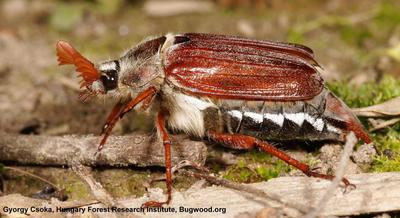Cockchafer
Melolontha melolontha
Insect
In a Nutshell
- Leaf wilting and yellowing.
- Root damage.
- Crop reduction.
Can also be found in
Symptoms
The grubs damage the rootlets, causing wilting of the plants and yellowing of the canopy. Roots can be stripped causing the complete destruction of grape vines.
Recommendations

Organic Control
Conserve natural enemies like Moles, Bats, Cuckoos, woodpeckers, sparrows, ground beetles, large wasps and Tachinid flies which are natural predators. Use pathogenic fungi like Beauveria bassiana or Metarhizium anisopliae. Parasitic nematodes, like Heterorhabditis megidis, put on the soils, can kill the grubs.

Chemical Control
Always consider an integrated approach with preventive measures together with biological treatments if available. Apply malathion 50% EC at 400 ml in 600-800 l of water/acre on your vineyard.
What caused it?
The damage is caused by the adult chafer of Melolontha melolontha. They are brown colored with a dark head. The female bug lays her eggs just below the soil surface in 10-20 cm depth. The larvae are whitish yellow, translucent and about 5 mm long. The fully grown grubs are stout with strong mandibles. Their head is yellowish and the white colored body is fleshy and 'C' shaped. Larvae overwinter as grubs in the soil and feed on plant roots. Their life-cycle takes about 3-4 years. Third instar larvae are the most voracious causing great damage to plants. Roots are eaten and tunnelled, so that the upper parts of the plants wilt and die. Adult beetles rest during the day and fly towards their feeding sites at dusk.
Preventive Measures
- Monitor your crop twice a week for the beetles and feeding damage.
- If the number of cockchafers is relatively small, remove the pest by hand and put them in a bucket with soapy water.
- Place barriers such as fleece around your vineyard to keep the adult beetles away.
- Install light traps as they attract them in large numbers.
- Eliminate larvae hibernating sites by ploughing the soil.
- Provide supporting environmental condition for parasitoids and natural predators as the feed on the larvae.
- In certain parts, they are also consumed as food.



